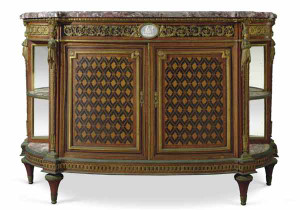
A French 19th Century Ormolu Marble-top Commode by Zwiener-Jansen Successeur
Zwiener-Jansen Successeur
Maker: Attributed to Joseph-Emmanuel Zwiener
Date: Late 19th Century
Dimension: 39(H) x 62(W) x 24(D) inches
Inspired by Charles Cressent, this darling rosewood commode showcases the increasingly favored theme of hilarious monkey antics. Named "commode aux enfants balançant un singe," the style is beloved by many. One is showcased in the Rothschild Collection at Waddesdon Manor, and another located within the Linsky Collection at the Metropolitan Museum of Art; two reside in the Gulbenkian Museum in Lisbon, and another is part of the collection at the Louvre.
Singerie — from the French for "Monkey Trick" — is a genre of art in which monkeys are depicted apeing human behaviour. Adorned with cast gilt bronze, the commode features a delightful scene on its front and sides where two children playfully swing a monkey on a rope amidst a lavish display of cast acanthus leaves. The central monkey ornament is portrayed in a playful fashion, wearing a jester costume consisting of a pointed hat and paneled skirt, complemented by two large exotic female busts on the corners of the entire composition. The theme of depicting humans and animals together, one which has been a part of decorative arts since the Mannerist period, was further developed in the late 17th century and reached its zenith during the rococo era. "Singerie" decorations, which include monkeys engaging in human activities, have adorned French decorative arts, appearing in tapestries, porcelain, and furniture, either in marquetry or, as in this instance, in sculptural gilt bronze. The piece has a hand carved and stamped foundry mark, of a coat of arms flanked by O/F.